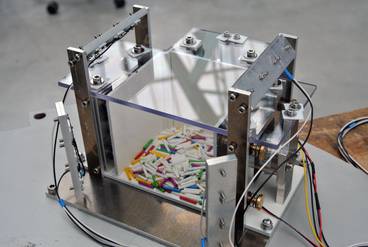granular anisotropic gases in drop tower (GAGa DropT)

research area: material science
experiment title:
Granular Anisotropic Gases in Drop Tower (GAGa DropT)
experiment acronym: DYT
funding agency:
ESA (Education) / ZARM
grant number:
Drop Your Thesis! - Program
performing organization:
Department of Nonlinear Phenomena, Faculty of Natural Sciences, Otto-von-Guericke Universität Magdeburg, Germany
prime investigator:
Prof. Dr. Ralf Stannarius
(Kirsten Harth, Kathrin May, Torsten Trittel, Sandra Wegner)
experiment objective
abstract
This experiment aims on the investigation of the behaviour of granular anisotropic gases in microgravity. Anisotropic granular gases are encountered in a number of situations - in avalanches, sandstorms, dust devils, the formation and motion of dunes, planetary rings, and the asteroid belt, to name a few. Study of anisotropic granular gases has, until now, been primarily restricted to numerical computer simulations.
We encounter granular materials every day, but they still offer a large variety of riddles and problems for scientists and engineers. During the past decades, the field moved from engineering and geosciences into the focus of contemporary physics. A general theory of granulates has not been developed yet. Similar to conventional materials, different aggregate states can be observed in granulates. Granular gases are loose, agitated ensembles of grains - like particles in a sandstorm or in the Saturn rings. In contrast to atomic gases, grains lose kinetic energy in collisions. Thus, energy must be constantly supplied to avoid clustering or sedimentation. A granular gas under stable conditions at low excitation is best maintained in microgravity. The dissipation is expected to affect the shape of the velocity and energy distributions in the gas and can lead to cluster formation. Literature comprises numerous analytical and numerical studies. Experiments are hard to realize and rare. Nearly exclusively granular gases of spherical or completely irregular grains are considered. In 3D investigations of granular gases of spherical grains, the Knudsen regime (mean free path larger than container size) or clustering were analysed.
During the last years, research interest in granulates composed of anisometric grains rose immensely. Various soft matter systems display an effective anisotropy due to anisometric shapes of the individual constituents. In granulates, flow alignment, particle ordering and giant density fluctuations were reported. Grains of non-spherical shapes as constituents of granular gases have only been little considered so far.
One experimental setup basically consists of a container with 3 individually tuneable vibrating walls and 2 cameras monitoring the granulate in the container from two perspectives during the micro-gravity period. The moveable walls will be used to excite the granular gases in microgravity.
The catapult capsule contains all in all 3 shaker / camera systems, so that in principle three different parameter sets can be recorded per catapult shot.
Five catapult shots were performed in the week from 3 to 7 December 2012 in the ZARM Drop Tower in Bremen. Prior to each shot, the excitation parameters for the shakers were set and calibrated. The specific granular materials were distributed on the bottom of the containers. High-speed video recording is started prior to lift-off, videos are stored on-board. Immediately after lift-off, the rods start rising from the bottom of the containers towards their top. A strong excitation was applied to the walls so that the rods distribute in the shaker, before the measurement parameters were set. From the stereoscopic video data, 3D positions and orientations of the rods are reconstructed. The trajectories are thendetermined and a statistical analysis will be performed. The results will be compared to literature data.
related publications
- Granular Anisotropic Gases in Drop Tower (GAGa DropT), Drop Your Thesis! 2012 - Final Report. ESA Human Spaceflight and Exploration, Erasmus Experiment Archive
experiment campaigns
experiment year: 2012
number of catapult launches: 5


 "
"